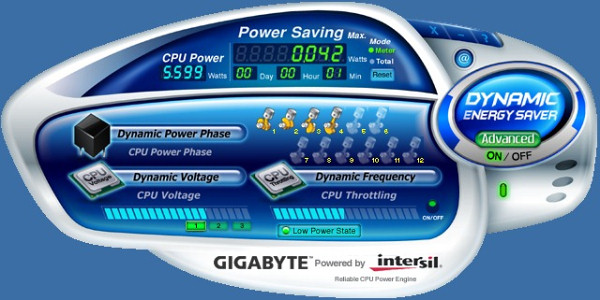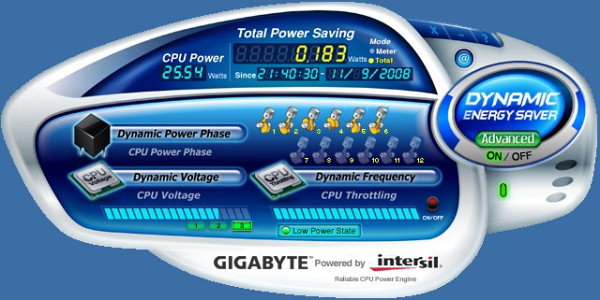Gigabyte EP45T-Extreme Motherboard
|
System monitoring (ITE IT8720F, in BIOS Setup and Windows utilities)
- Voltages on a processor, memory, and +5 V
- RPM of four fans
- CPU and board temperatures (by the corresponding embedded sensors), and Northbridge temperature
- Automatic fan speed control is limited to the choice of control type (depending on a fan model -- with 3- or 4-pin connectors -- reduce voltage or PWM), but you cannot specify thresholds.
Gigabyte EasyTune 6 for Windows allows to specify parameters for automatic control: you can set the top and bottom temperature thresholds (fan speed between these values varies proportionally to the temperature), as well as fan speed for the temperature below the bottom threshold (you cannot stop the fan though). Special utilities, like SpeedFan, certainly have more features to control coolers.
Onboard ports, sockets, and connectors
- Socket 775, supports Core 2 Duo/Quad/Extreme, Pentium Dual-Core, and Celeron 400/Dual-Core with FSB operating at 800-1600 MHz (although 1600 MHz is not officially supported by this chipset), including models with Wolfdale/Yorkfield cores; the list of processors tested for compatibility is published on the official website
- 4 x DDR3 SDRAM DIMM (up to 8 GB of DDR3-800/1066; dual-channel mode is supported even if memory slots are not filled symmetrically); the list of certified modules is published on the official website
- 3 x PCIEx16, two of them comply with the PCI-E 2.0 standard, they can work simultaneously at x8 speed to support two graphics cards in CrossFireX mode, only the first slot works differently at full speed; the third slot is based on the PCI-E 1.1 controller in the Southbridge, its maximum speed is x4
- PCIEx1 slot (disabled, when an expansion card is installed into the third PCIEx16 slot)
- 3 x PCI
- Power connectors: standard ATX 2.2 (24 pins, you can also plug a regular 20-pin ATX 2.03 connector), and 8-pin EPS12V for a processor (you can also plug a regular 4-pin ATX12V connector even without an adapter)
- 1 x FDD
- IDE (Parallel ATA) based on the additional ITE controller for two ATA133 devices
- 6 x chipset-based SATA-II (Serial ATA II) for six SATA300 devices, connected disks can form RAID 0, 1, 0+1, 5, and Matrix RAID
- 2 connectors for brackets with 4 additional USB ports
- 3 connectors for brackets with 3 additional FireWire ports
- Connector for a COM port on a bracket
- 1 x CD/DVD audio connector
- Connectors for analog audio ins and outs on the front panel
- Connectors for S/PDIF-In/Out on a bracket, digital output can be plugged to a graphics card or any expansion card that can channel audio through HDMI
- Connector for a Chassis Intrusion sensor
- Four fan headers, one of system headers and a CPU header are 4-pin connectors; all of them allow to control fan speed, and the CPU fan connector supports automatic fan speed control depending on temperature
Back panel (left to right, blockwise)
- PS/2 mouse and keyboard
- Coaxial and optical (Toslink) S/PDIF-Outs
- Clear CMOS button
- 4 x USB
- 2 x USB 2.0 and 1 x RJ-45 (Gigabit Ethernet)
- 2 x USB 2.0 and 1 x RJ-45 (Gigabit Ethernet)
- 6 x analog audio jacks: Center/Sub, Rear, Side, Line-In, Front, Mic-In.
It would have been great to have at least one FireWire and eSATA on the rear panel. It goes without saying that engineers from Gigabyte used the space quite inventively, having added such exotic connectors as S/PDIF-Out of both types and Clear CMOS button, as well as plenty of USB ports. But the backside of the on-board heat sink might have been replaced with the above-mentioned connectors, provided the motherboard is installed in a well-ventilated PC enclosure.
Bundle
We received this motherboard without its bundle, so we use Gigabyte data for this chapter.
- Documentation: full User Manual in English as well as a brief Install Guide and instructions how to install an Intel processor with a boxed cooler (in several languages).
- Cables: 4 x SATA (without power splitters), 1 x ATA66, and 1 x FDD
- 2 x eSATA kit for the rear panel: a bracket with two eSATA ports and one IDE power connector to be plugged to corresponding connectors inside a PC enclosure, an external IDE-SATA power converter, an external eSATA-SATA interface converter
- A rear panel bracket with two FireWire ports (4- and 6-pin)
- Hybrid Silent-Pipe for the on-board cooling system
- Rear I/O shield
- DVD with drivers and utilities as well as shareware software (including Kaspersky Anti-Virus 6.0)
The set of proprietary utilities includes the following programs:
- EasyTune 6 -- system monitoring, detailed information on a CPU and memory (like CPU-Z), automatic CPU fan speed control settings, and automatic overclocking options, including GPU overclocking.
 
- DES (Dynamic Energy Saver) -- power management. It can change dynamically the number of working channels in the PWM controller of the VRM depending on its load (in case of our Core 2 Duo E8200 operating in its nominal mode, the number of channels never exceeded eight), lower CPU voltage according to a selected profile (one of three), force chipset throttling to reduce CPU frequency. DES displays the current power consumption level of a processor and calculates the amount of conserved power. This utility requires to enable power saving technologies (EIST and CPU Enhanced Halt (C1E)) in BIOS Setup (or in any other way -- for example, using RMClock). However, system overclocking does not interfere with DES. On the whole, modern games of manufacturers, who let users overclock their systems almost twofold and then try to save a Watt fraction, look really funny.
- @BIOS updates BIOS in Windows, it can search for the latest firmware version in Internet.
- Face Wizard integrates a custom logo to BIOS, which will be displayed at startup.
- Q-Share -- this strange utility seems to organize file exchange between several computers in a configured TCP/IP network (you just have to specify a shared folder, if you don't like the default path). I don't understand why Q-Share is better than the standard Windows solutions.
- C.O.M. (Corporate Online Manager) -- this utility gathers information about configurations of computers (based on Gigabyte motherboards supporting C.O.M.) in a local area network. It helps diagnose problems in remote computers (detect a fan failure or CPU overheating, wrong driver versions) as well as to turn it on/off or hibernate it.
- Time Repair uses standard Windows tools to create new restore points and roll back to one of them.
Write a comment below. No registration needed!
|
|
 |
|
|
|



